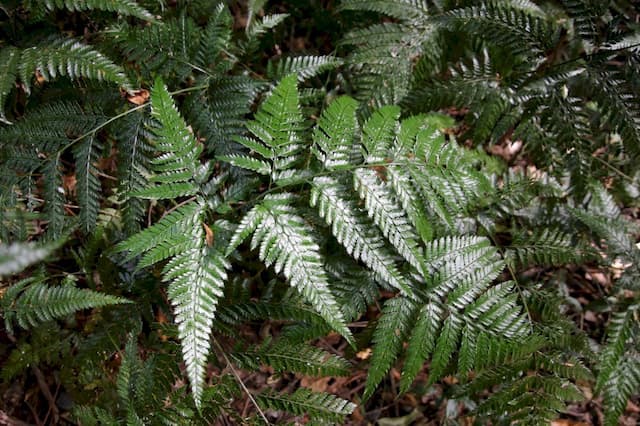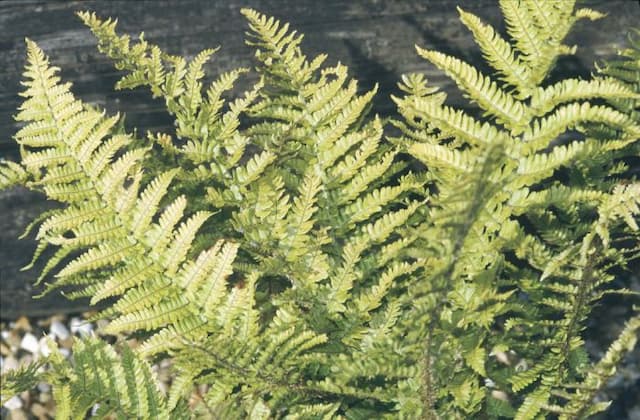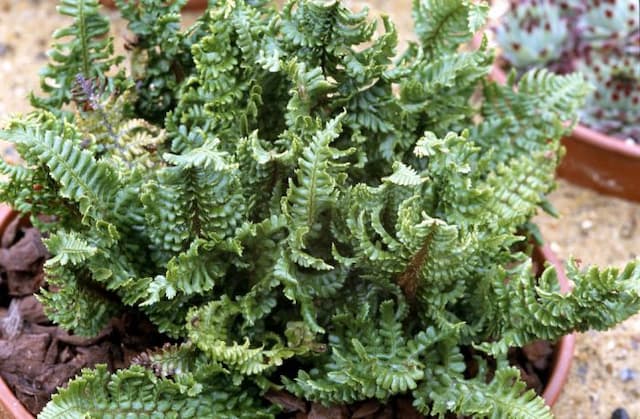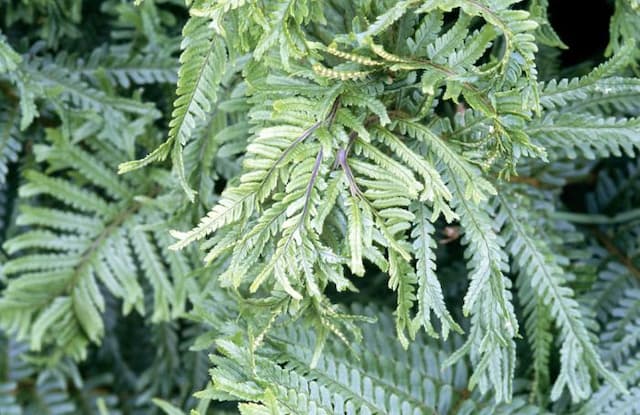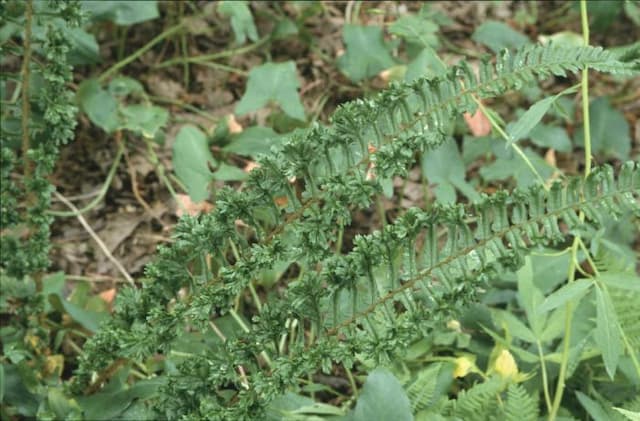Soft shield fern Polystichum setiferum Divisilobum Group











ABOUT
Commonly known as the soft shield fern, Polystichum setiferum Divisilobum Group is a type of fern with a delicate, lacy appearance. Its fronds are finely divided, which contributes to its soft and feathery look. The fronds emanate from a central point, creating a somewhat circular shape as they unfurl. They are typically a rich, deep green color, and their surface texture is smooth to the touch. The soft shield fern has a dense and bushy habit, with numerous fronds emerging in a tufted fashion. The leaflets, or pinnae, on each frond are split and deeply dissected, appearing intricate and complex. The edges of these leaflets are often slightly ruffled or crinkled, which adds to their delicate and ornate charm. The individual pinnae are arranged in a way that gives the fronds an overall feathery look. The plant's stems, or stipes, are also green, and sometimes show a contrast in color or texture compared to the fronds. Overall, the soft shield fern presents an image of lush, fine-textured greenery that brings a sense of elegance and woodland charm to the areas where it grows. Its detailed frond structure and lush appearance make it a popular choice for garden enthusiasts seeking to add a fern with a particularly graceful and refined look to shaded garden spaces or fern collections.
About this plant
 Names
NamesFamily
Dryopteridaceae
Synonyms
Soft Shield Fern, Divisilobum Group Fern
Common names
Polystichum setiferum Divisilobum Group.
 Toxicity
ToxicityTo humans
Soft Shield Fern is considered non-toxic to humans. Therefore, it does not pose any significant risk of poisoning upon ingestion, and there are typically no symptoms associated with consuming this fern. However, it is always recommended only to ingest plants that are known to be safe and are prepared correctly.
To pets
Soft Shield Fern is also deemed non-toxic to pets. Similar to humans, ingestion of this plant should not lead to any severe symptoms of poisoning in animals such as cats or dogs. Even though it is not poisonous, it is generally advisable to prevent pets from eating plants to avoid any potential gastrointestinal upset.
 Characteristics
CharacteristicsLife cycle
Perennials
Foliage type
Evergreen
Color of leaves
Green
Height
3-4 feet (0.91-1.22 m)
Spread
2-3 feet (0.61-0.91 m)
Plant type
Fern
Hardiness zones
8
Native area
Europe
Benefits
 General Benefits
General Benefits- Eco-friendly Landscaping: The plant is well-suited to sustainable gardening practices, requiring minimal care once established and reducing the need for chemical fertilizers and pesticides.
- Wildlife Support: Provides habitat and supports biodiversity by offering shelter and food sources such as insects for birds.
- Soil Erosion Control: Its root system helps stabilize soil, preventing erosion especially in shady, sloped areas.
- Aesthetic Appeal: Soft Shield Fern, as it's commonly known, adds texture and beauty with its feathery, lush green fronds, enhancing garden designs.
- Low Maintenance: It's a hardy perennial that requires little upkeep beyond occasional watering and cleaning of dead fronds.
- Shade Tolerant: Thrives in shady areas where other plants may struggle, making it ideal for woodland gardens or shaded borders.
- Seasonal Interest: Provides year-round visual interest, especially in temperate climates where it can remain evergreen in mild winters.
- Versatile Planting: Suitable for a variety of garden styles, including formal, cottage, and woodland gardens, as well as container gardening.
 Medical Properties
Medical PropertiesThis plant is not used for medical purposes.
 Air-purifying Qualities
Air-purifying QualitiesThis plant is not specifically known for air purifying qualities.
 Other Uses
Other Uses- Polystichum setiferum, commonly known as Soft Shield Fern, can be used in floral arrangements and bouquets for its delicate foliage and texture contrast.
- Soft Shield Fern can serve as a natural mulch, its fronds keeping soil moist and cool when they fall around the base of the plant.
- With its elegant form, the Soft Shield Fern is ideal for ornamental use in shady courtyard gardens, providing a lush, green backdrop.
- Used as a natural pest deterrent in gardens, some gardeners believe that ferns can ward off common pests like aphids and whiteflies.
- This fern can be planted near water features, such as ponds or streams, to create a naturalistic planting that blends with the water landscape.
- In shaded rock gardens, the Soft Shield Fern can compliment the stony environment with its soft foliage, contrasting with the hard textures.
- The plant can also serve as a habitat for small garden wildlife, offering cover and cool resting spots during hot days.
- This fern species can be used in theme gardens, such as a fernery or woodland garden, to contribute to species diversity and visual interest.
- Soft Shield Ferns can act as natural indicators of soil and air moisture, with their fronds showing signs of drying when environmental conditions change.
- They can also be an educational tool in schools and conservation programs to teach about plant adaptation and foliage structure in shade-loving plants.
Interesting Facts
 Feng Shui
Feng ShuiThe Soft Shield Fern is not used in Feng Shui practice.
 Zodiac Sign Compitability
Zodiac Sign CompitabilityThe Soft Shield Fern is not used in astrology practice.
 Plant Symbolism
Plant Symbolism- Endurance: Polystichum setiferum, commonly known as the Soft Shield Fern, can grow in shade and survive under larger trees, symbolizing the ability to endure challenging conditions and thrive.
- Protection: The fern's fronds overlap in a manner that resembles a shield, which can be interpreted as a symbol of shelter and safety.
- Eternal Youth: Ferns are ancient plants that have outlived many other species, and the Soft Shield Fern, with its lush greenery, represents the idea of evergreen youth and vitality.
 Water
WaterThe Soft Shield Fern should be watered deeply but infrequently, allowing the soil to dry out slightly between waterings. During the growing season, watering once a week with approximately 1 gallon per plant should suffice. In hotter, drier conditions, you may need to water twice a week, but always check the soil moisture first. During winter, when the plant is not actively growing, reduce watering to every two to three weeks, providing just enough water to prevent the soil from completely drying out.
 Light
LightThe Soft Shield Fern thrives best in partial to full shade, making it an ideal plant for a shaded garden spot or beneath a canopy of larger trees. It should be protected from direct sunlight, which can scorch its delicate fronds. The ideal lighting condition is dappled shade, which mimics its natural forest floor habitat.
 Temperature
TemperatureThe Soft Shield Fern performs well in a temperature range of 50-70°F, which are typical indoor conditions. It can survive minimum temperatures down to about 20°F but will need protection from frost. The fern prefers a cool environment and might struggle in temperatures consistently above 80°F.
 Pruning
PruningPruning the Soft Shield Fern is usually not necessary for the health of the plant, but can be done for aesthetic reasons or to remove damaged fronds. It should be done in early spring before new growth starts. Cut away any old or damaged fronds at the base to encourage fresh growth. Pruning is only needed once a year.
 Cleaning
CleaningAs needed
 Soil
SoilSoft Shield Fern prefers moist, well-drained soil rich in organic matter with a pH range of 5.5 to 6.5. A good mix might include garden compost, leaf mold, and coarse sand to ensure proper drainage.
 Repotting
RepottingSoft Shield Ferns do not require frequent repotting; every 3-4 years is sufficient, or when the plant outgrows its container.
 Humidity & Misting
Humidity & MistingSoft Shield Fern thrives at high humidity levels, ideally between 60% and 70%.
 Suitable locations
Suitable locationsIndoor
Place in a shaded spot with high humidity levels.
Outdoor
Plant in a shaded, moist, and well-drained spot.
Hardiness zone
5-8 USDA
 Life cycle
Life cycleThe Soft Shield Fern, Polystichum setiferum Divisilobum Group, begins its life cycle with spore germination, which occurs under moist conditions conducive to fern propagation. The microscopic spores develop into a gametophyte, a small, heart-shaped thallus that houses both male and female reproductive organs. Once mature, the gametophyte facilitates fertilization, allowing for the development of a new sporophyte—the familiar, leafy fern plant. This young fern grows through a juvenile phase with smaller, less divided fronds, eventually reaching maturity where it forms its iconic, finely divided, feathery fronds. Mature ferns are perennial and will continue to produce new fronds every growing season, often forming dense, shuttlecock-like clumps. In the right conditions, mature ferns will produce spores on the undersides of their fronds, completing the life cycle as these spores are dispersed to grow new gametophytes.
 Propogation
PropogationPropogation time
Early Spring
The Soft Shield Fern (Polystichum setiferum Divisilobum Group) is best propagated through division, which is a common method for many ferns. This method typically takes place in the spring, just before new growth commences. To propagate by division, carefully uplift the parent plant from the ground, ensuring you have a generous amount of roots. Using a sharp knife or spade, divide the root ball into several sections, each with a portion of the roots and at least one growing crown. Replant each section at the same depth it was originally growing, spacing them approximately 12 inches (about 30 centimeters) apart to allow for growth. Water the new plants thoroughly to settle the soil around the roots and keep the soil consistently moist (but not waterlogged) as they establish.
